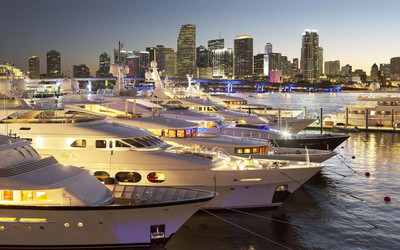The Basics of Marine Air Conditioners
Apr 19th 2021
Air conditioners for marine applications can be divided into 3 main categories. These categories are self-contained air conditioners units, split air conditioners systems and marine chiller systems also known as chilled water systems. All these systems have one commonality which is that they use water from the sea or lake to cool air in an efficient and consistent manner. That said, the different systems go about it in quite different ways, and each has pros and cons.
Self-contained units are a compact design that integrates all its components in a single chassis. These components are the compressor, evaporator tower, cooling coils, blower and an electrical box containing the control board and other electrical components. Having a small footprint allows them to be installed in the actual room they are meant to cool or heat usually underneath seats, inside closets or drawers or under beds.
These units are better suited for boats 45’ and under. They can also be a great solution when adding air conditioning to new areas that did not have ac units before like crew quarters, a flybridge, engine rooms, cockpit, etc.
Pros:
- Easy to install as they come pre-charged. There is no need to deal with refrigerants or welding of any kind.
- Less weight and footprint than other systems.
- Least expensive when compared to the other marine air conditioner systems on this list.
- Easy to maintain.
Cons:
- They can be noisier that the other systems since the Compressors are usually located in the rooms they are meant to cool.
- You might feel vibration coming from the AC.
- They are larger than air handlers or evaporators requiring more space in the actual rooms.
Most recognized models:
- Dometic Turbo DTG Series: The Dometic DTG series of air conditioners offers a wide range of models varying in capacity including the DTG 16, DTG 12, DTG 10, DTG 8 and DTG 6. All these models are available in 115V and 230V and they all work with both 50hz and 60Hz which eliminates the need of any voltage regulating devices and literary takes away national borders for vessels. Boaters can now just plug into any shore power at any harbor around the world.
- Dometic ECD Series has three models offering different capacity ratings. Their models are ECD16, ECD10 and ECD6. All of them come in 115V or 230V and are rated at 60Hz. This line price point is makes it accessible to all boaters. It also comes with a new display included in the package.
Split air conditionersconsist in two main parts. There is the condensing unit, usually located in the engine room, and one or more evaporators located in one or more rooms. The condensing connects to the evaporators, located in the rooms they are meant to cool or heat, using insulated copper pipes that contain the compressed refrigerant.
This units are recommended for larger boats ranging from 40’ to 80’ approximately that can accommodate the compressors in their engine rooms. This type of system can set up one condensing unit with up to 3 evaporators in different areas.
Pros:
- Having the condensing unit (compressor) in the engine room or other isolated area will drastically reduce the sound levels heard by users inside the vessel.
- One condensing unit can handle up to 3 evaporators which in turn will require less space inside than self-contained units.
- Wide range of evaporator options in different sizes and shapes.
Cons
- They can cost more than a same capacity self-contained unit.
- Installation is more complex requiring. It requires welding, piping, and handling refrigerants.
- Unless the split system is modular, all evaporators connected to the condensing unit can only be controlled with one display.
- Do not have as large capacity as chillers do.
Most recognized models:
- Dometic RX Series Condensing Units offer a wide range of models anywhere from 10,000 BTU to 48,000 BTU in 230V and from 10,000 BTU to 16,000 BTU in 115V. This series of condensing units is offered with R417A refrigerant and are also compatible with R22 making them compatible with systems in most older boats.
- Dometic DEU Emerald Series Condensing Units. This series comes with even larger range of model that range from 6,000 BTU to 72,000 BTU. The Emerald condensing units work with R410A which is considered to me a more environmentally friendly refrigerant.
Chilled Water Systemsare composed of one or more chiller units connected to one or more air handlers using a cooled or heated water loop. Chillers can be combined to create a system that is generally higher in capacity than other leisure marine air conditioner systems. This allows one chiller system to be used with many air handlers in different rooms. Each air handler can be controllers with its own thermostat or display giving the user more flexibility when setting up different temperatures in different places. Additionally, a system that is composed of more than one chiller will only use one unit according to the capacity required at a particular moment.
Chiller systems are usually found on yachts of 80’ or more. The ability to control each air handler individually and the increased capacity makes them ideal for larger yachts. They come a wide range of models to fit any application.
Pros:
- Chillers can supply many air handlers individually.
- Great for larger boat air conditioner applications.
- Air handlers can be controller individually.
- Wide range of chillers and air handlers to choose from.
Cons:
- Chillers are expensive.
- Installation is complex.
- There are more economical options for smaller yachts.




